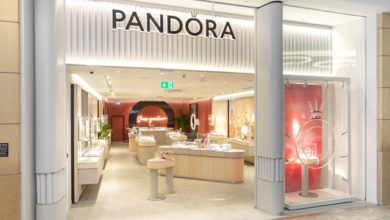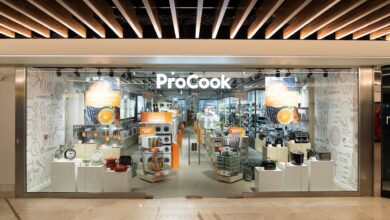How AI is hijacking fashion retailers’ hard-won website traffic
AI-generated overviews are slashing click-through rates and reshaping how shoppers discover products online. For fashion and beauty brands, it’s a wake-up call: the old SEO rules no longer guarantee visibility, and adapting means rethinking everything from keywords to customer loyalty.

Register to get 1 free article
Reveal the article below by registering for our email newsletter.
Want unlimited access? View Plans
Already have an account? Sign in
For more than two decades, fashion and beauty brands have lived and died by the rules of Google’s search engine. From carefully crafted meta descriptions to blogs seeded with trending terms, the quest to climb search rankings has been one of the industry’s most consistent (and most costly) marketing obsessions. But in the span of less than a year, the rise of AI-generated overviews is shaking up that order, and rewriting both the rules of SEO and the entire landscape of online discovery.
In its recent analysis of volunteered browsing data, the Pew Research Center observed a sharp behavioural shift: when Google’s AI-generated “answer boxes” appear at the top of a search results page, the share of users clicking through to a traditional website drops almost in half – from about 15% to just 8%. For queries that once would have sent curious shoppers deeper into brand ecosystems, the AI summary itself now often serves as the destination, offering an authoritative, multi-source synthesis of information before a single scroll.
Traffic analytics company SimilarWeb has tracked a parallel trend. Its aggregated data shows that the introduction of AI overviews correlates with a sustained decline in organic visits to content-heavy publishers, particularly in lifestyle categories like fashion and beauty, where search is often discovery-driven and intent-rich. While the magnitude varies by query, it’s looking like AI is already changing how consumers use search engines.
Google, for its part, downplays the disruption. Executives have publicly stated that outbound clicks from Search have remained “relatively stable” year-on-year, insisting that AI is not replacing but complementing traditional results. However, brand marketing teams are already moving resources toward strategies that prioritise AI visibility alongside (and in some cases above) traditional SEO.
One such voice urging decisive change is Dr A.K. Pradeep, founder and chief executive of Sensori.ai, who works extensively with global fashion and beauty retailers. “Traditional SEO is flatlining,” Pradeep says bluntly. “While brands scramble to optimise for keywords that AI overviews ignore, smart retailers are already pivoting to what I call ‘neural commerce’ – mirroring how human brains actually search and discover products.”
For Pradeep, the shift is not cosmetic but structural. AI overviews prioritise contextual understanding – the ability to grasp intent, nuance and emotional resonance – over mechanical keyword matching. “Fashion and beauty brands clinging to keyword-stuffed product descriptions,” he warns, “are watching their organic traffic haemorrhage to AI-generated answers that prioritise contextual understanding over search term density.”
In this new paradigm, the brands that thrive will not be those with the most backlinks, but those whose product data “speaks the same contextual language as both human shoppers and large language models”. Pradeep’s conclusion is unequivocal: “While competitors debate AI’s impact, forward-thinking retailers are already implementing LLM-native product discovery that makes their inventory as findable to AI as it is intuitive to humans. This isn’t about surviving the AI revolution – it’s about leading it.”
But not everyone is ready to write the obituary for SEO. Robin Harrison, global VP of marketing at Intellias, sees the changes less as an ending than as a necessary evolution. “SEO isn’t dying, far from it. Rather it’s undergoing a profound and exciting evolution,” he says. “Let’s be clear: traditional search, as we’ve known it, is transforming. If brands want to capture the next click, they must fully understand and embrace these shifts. This will also necessitate a change in their mindset regarding what truly constitutes success.”
Harrison identifies several forces converging at once. “Users are increasingly turning to generative AI engines directly, often supplementing or even replacing traditional search,” he explains. “While this shift might impact the vanity metrics some brands prioritise, these generative AI platforms – like ChatGPT – are driving small but highly valuable traffic. In short, traffic that converts.”
Conversely, there is also a long game to consider. AI models are not updated daily; many refresh only every six months or so. That means brands need to think in terms of training the long-term model and planning far ahead, rather than chasing transient keyword trends. “The future demands a strategic evolution of SEO – but not only this – it also involves a strategic evolution of our mindsets about what good looks like,” Harrison adds. “Today it’s less about keyword stuffing and more about creating high-quality, authoritative, and user-centric content that AI can understand.”
For him, this is a shift that rewards substance over manipulation. “This change prioritises quality and makes it harder for people to play an SEO game,” he continues. “Businesses that embrace these changes, leverage AI tools intelligently, and prioritise their user experience will be best positioned for success in this new era of search.”
While Google’s AI overviews are causing much of the industry anxiety, they are not the only factor reshaping traffic flows. Rachel Auty, media account director at IMA, sees another trend emerging in parallel: the integration of social media content directly into search results.
“AI-generated answers on Google are reshaping how UK fashion and beauty brands drive visibility and traffic,” she notes. “Brands are seeing a decline in organic visits, as AI overviews summarise content without requiring a click. This shift highlights the importance of evolving search strategies from traditional keyword ranking to being cited, seen and trusted across every format Google displays.”
At the same time, Auty points out, Instagram posts – especially those that are visually led and trend-focused – are surfacing more often in search results. “Optimising visual, trend-led content for search is becoming essential,” she says. That creates new openings for fashion and beauty marketers willing to think beyond text and invest in multimedia discoverability.
Her prescription is threefold: “Strengthen on-site authority and optimise well-structured content across all channels; invest in influencer partnerships that drive branded search volume, where AI answers are less disruptive; and treat platforms like Instagram and TikTok not just as engagement tools, but as part of your search strategy.”
In other words, SEO now extends to every surface where a consumer might begin their journey – whether that’s the search bar or the For You page. “It’s about being referenced and represented wherever search journeys unfold,” Auty says. “Including in AI overviews. Fashion and beauty brands need to adapt quickly to stay front-of-mind and in-feed.”
For Dr Antonio Marsocci, a business and executive coach who has advised fashion and lifestyle brands across Europe for more than 20 years, the most concerning consequence of AI in search is not simply reduced traffic, but the loss of control over the customer’s journey.
“AI-powered search summaries are already cutting into organic traffic for fashion and beauty brands,” Marsocci notes. “But the bigger problem is how they’re shifting control away from the brand’s own site. If a shopper gets everything they need from the AI box at the top of search results – including product suggestions, reviews and prices – they never visit your homepage.”
That absence matters. As Marsocci warns, “It removes your chance to shape the experience, show your full collection, or even collect an email address.” For smaller brands especially, Marsocci advises close monitoring of which search terms now trigger AI summaries, and whether their content is being cited at all. “If you are not appearing there, your top-of-funnel traffic may already be falling – even if it is not obvious yet in your analytics.”
Some see AI as a threat to acquisition, while others see an opportunity to double down on retention. Fiona Stevens, brand marketing director at LoyaltyLion, believes loyalty programmes may become one of the most valuable tools in the AI era.
Stevens, who agrees that AI-generated search results are one of the biggest disruptors to hit ecommerce in years, says, “Fashion and beauty brands are seeing a real shift in how shoppers discover products. Where SEO used to drive clicks to carefully crafted pages, Google’s AI summaries now pull information from multiple sources, reducing site visits and raising questions over brand visibility, control, and conversion.”
Her answer is to focus on owned relationships. “If traffic is harder to win, retention becomes more valuable,” she explains. “Loyalty programmes help keep shoppers engaged, even when search habits change. They generate reviews that feed AI summaries, drive social follows and newsletter sign-ups that brands still control, and build pools of zero-party data that allow for more personalised, meaningful engagement.”
More than just a defensive tactic, loyalty can also support discovery. “AI tools love detailed product feedback, community content, and consistent engagement signals,” Stevens notes, “and good loyalty programmes deliver all of that. When you can’t guarantee where your brand will show up in search, loyalty offers a way to meet your customers where they are, build direct relationships, and make sure they come back.”
The message from all corners of the industry is the same: ignoring AI’s influence on search is no longer an option. Whether you see it as an existential threat, a catalyst for innovation, or both, the tools and habits shaping consumer discovery are evolving faster than many marketing playbooks can keep up. In the words of Dr Pradeep: “We’re not just optimising for Google anymore; we’re optimising for how people actually think and discover.”







